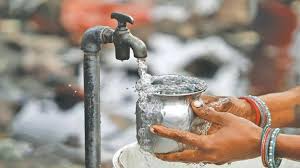Centre forms 12 additional teams to review Jal Jeevan schemes

The Government of India has announced the formation of 12 new review teams. These teams will monitor the progress and implementation of the Jal Jeevan Mission (JJM). This move aims to strengthen oversight and speed up the delivery of safe drinking water to rural households.
About the Jal Jeevan Mission
Launched in August 2019, the Jal Jeevan Mission aims to provide every rural household with safe drinking water by 2024. The mission focuses on connecting over 19 crore rural homes to functional tap water connections. This effort seeks to improve public health and promote sustainable water management.
The program plans to replace traditional water sources, such as wells and hand pumps, with reliable household taps. This shift will ensure safer and more convenient water access for rural families.
Why Add More Review Teams?
Despite progress, the mission faces many challenges due to India’s size and diversity. Water infrastructure development, quality control, and community involvement require continuous attention.
To tackle these challenges, the government has formed 12 new teams. They will conduct frequent field reviews and inspections. This step will complement existing monitoring bodies and increase the mission’s oversight.
Experts say these teams will spot region-specific problems quickly. They will enable faster action to fix issues. Thus, the mission will maintain steady progress across all regions.
Roles and Responsibilities of the New Teams
The new teams have clear responsibilities:
- Field Inspections: They will visit sites across various states. Their goal is to check pipelines, water treatment units, and storage tanks.
- Water Quality Checks: Teams will regularly test water to ensure it meets safety standards set by the Bureau of Indian Standards and the World Health Organization.
- Community Engagement: The teams will communicate with local Gram Panchayats and residents to gather feedback on water supply and service quality.
- Reporting: They will submit detailed reports to the Ministry of Jal Shakti. These reports will highlight progress, challenges, and suggestions for improvement.
- Capacity Building: Beyond inspections, teams will help train local water operators. They will also raise awareness about water conservation and hygiene.
Impact on Rural Communities
Adding more review teams will speed up infrastructure completion. It will also help resolve issues like pipeline leaks and irregular water supply faster.
Access to safe drinking water reduces waterborne diseases such as diarrhea and cholera. These illnesses often affect rural communities the most. The mission’s success will therefore improve rural health significantly.
Challenges and the Way Forward
Some areas still face hurdles due to terrain, lack of technical skills, and water scarcity. The new teams will need to adopt tailored strategies for such regions. Working closely with local officials will be key.
Using technology like GIS mapping and real-time monitoring will also boost review efficiency. Moreover, community participation remains vital. Involving local water groups and educating users about water-saving practices will help maintain infrastructure.
Government’s Commitment and Vision
The new teams show the government’s strong commitment to Jal Jeevan Mission’s goals. The mission aligns with the United Nations Sustainable Development Goal 6, which aims for universal access to safe drinking water.
The government wants to create a model rural water supply system that ensures health, dignity, and empowerment. They focus not just on building infrastructure but also on providing reliable service.
Conclusion
Forming 12 new review teams marks a crucial step in strengthening the Jal Jeevan Mission’s monitoring. These teams will bring focus, accountability, and local insight to the mission.
With continued government support and active community involvement, the vision of ‘Har Ghar Jal’—safe tap water for every rural home—can soon become a reality. This will improve health and quality of life across India’s villages.






